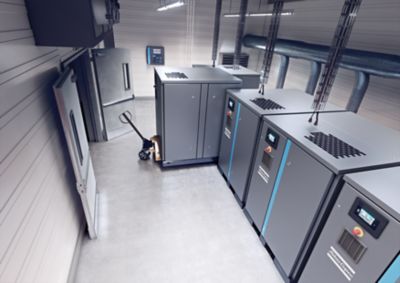What you need to know about compressed air desiccant dryers
Andy Lill, Atlas Copco’s Business Development Manager – Quality Air, outlines the need for dry compressed air, looks at the operation of traditional heatless desiccant dryers, and reveals the benefits of the latest zero-purge desiccant dryer developments.
Why industry needs really dry air
As any physics student can confirm, air in the atmosphere always contains moisture in the form of water vapour that’s not always welcome. In compressed air, it has the potential to cause problems. The result can be high maintenance costs, shortened service life and impaired air-user performance. Ultimately, untreated air can lead to premature failure of pneumatic equipment. It can also lead to a high rate of end- product rejection, increased leakage, disturbances in instrumentation and control systems, and shorter service life for pipework due to corrosion.
Choosing a reliable desiccant dryer is therefore essential to protect production systems and processes, maintain the quality of end products and minimise energy costs.
Dryer technologies
Regenerative-desiccant-type dryers are the primary choice for compressed air users within the pharmaceutical, chemical, and food and beverage manufacturing industries.
They feature a porous desiccant that adsorbs the moisture by collecting it in its myriad pores, allowing large quantities of water to be retained by a relatively small quantity of desiccant. The desiccant medium has a finite capacity for adsorbing moisture before it must be dried out or regenerated. Normally, the desiccant is contained in two separate towers. Compressed air to be dried flows through one tower while the desiccant in the other is being regenerated. This is accomplished by reducing the pressure in the tower and passing previously dried purge air through the desiccant bed.
The regeneration air may also be heated, either within the dryer or externally, to reduce the amount of purge air required. Regeneration air may also be supplied by a blower and dryers of this type normally have a regeneration cycle, which can be based upon time, dew point or a combination of the two. The regeneration method depends on the type of desiccant dryer: heatless desiccant dryers or heated blower purge dryers.
Heatless desiccant dryers
Heatless dryers use only compressed air as a purge. Because of their simple design, heatless desiccant dryers are often preferred for extreme environments. This sector includes operations in remote areas, hazardous sites with explosive gases and powders, and applications with a high inlet air temperature.
In the drying process, wet compressed air flows upward through the desiccant which adsorbs the moisture, from the bottom to top of the tower.
During the regeneration cycle, dry air from the outlet of the drying tower is expanded to atmospheric pressure and passed through the saturated desiccant, forcing the adsorbed moisture out. After desorption, the purge silencer valve is closed, and the vessel is re-pressurised. After regeneration, the functions of both towers are reversed.
Heated blower purge desiccant dryers
Blower purge desiccant dryers use a combination of ambient air from an external blower, heat and a minimal supply of compressed air. In the drying process, wet compressed air flows upward through the desiccant, which adsorbs the moisture, again from bottom to top.
In the regeneration stage, the blower takes ambient air and blows it over an external heater. The heated air is then sent through the saturated desiccant, forcing the adsorbed moisture out.
This stage is followed by a cooling purge: After the heating process is completed, the hot tower of desiccant is cooled by expanding dry compressed air from the outlet of the adsorbing vessel over the hot reactivated tower cooling the desiccant prior to use. As with the heatless process, the function of both towers is then switched automatically.
Superior energy efficiency
Dryers’ relative life cycle cost - heatless v. heated blower
When calculating lifecycle costs, a heatless desiccant dryer may be considered to be more expensive to own because it uses a substantial volume of compressed air for purging during regeneration. Typically, average purge air takes up to 16-20% of the rated flow capacity of a heatless dryer.
Despite these losses, the heatless dryer remains a popular choice because of its simplicity and reliability. However, if we compare the total cost of ownership between the two types of dryer over a 10-year lifetime, the heated blower purge type of unit has the advantage over the heatless desiccant method by some 40%.
Although power costs for the heating process would amount to 30% as opposed to zero, this difference is considerably outweighed by the compressed air output losses from the purging operation, which equates to 80% of the TCO.
In terms of other component costs, there are now newer and more advanced dryer technologies, such as the latest models in Atlas Copco’s BD+ range that will guarantee a dew point down to -40°C and are capable of achieving -70°C. Furthermore, the zero purge losses achieved by the industry-leading BDZP dryers, operating with an inlet flow rate of 300 l/s with a system pressure of 7 Bar G, could see annual savings in the region of £10-14k, based on average kW/hr rates and when running 24/7 all year round.
Conclusion
The overall conclusion is that for more demanding installations where a negative dew point is required adsorption dryers are regarded as the only valuable solution. But it is a solution that comes with a caveat.
Although the initial purchase price of a heatless desiccant dryer may appear to be attractive, the running costs are extremely high in comparison to other dryer systems. This type of dryer can best be used in applications with a low amount of running hours, or as a back-up unit in a compressed air network to take over in case of issues with the main dryer. On balance, it would appear that dryers featuring heated blower purge with zero purge cooling are the most economical alternative.


